The Swift
Swifts are the most incredible birds (in my very biased opinion) as they spend the vast majority of their lives in the air. They eat, sleep and mate on the wing and only land to nest. Their scientific name, Apus apus, is derived from ‘a’ meaning ‘without’ and ‘pous’ meaning ‘foot’, as it was traditionally believed they had no feet. In reality they have small feet on very short legs giving the appearance that they have no feet. But as they only land to nest, they have little use for feet. They are with us in the UK for just a few short months, arriving in early May and departing by mid-August, where they then spend the winter in equatorial and southern Africa.
Being strictly aerial, Swifts feed on flying invertebrates such as aphids. They are built for flying with streamlined bodies and long, slender wings. This means they are very agile flyers and are known to reach top speeds of 69mph in level flight (the fastest official record for a bird in level flight1). Swifts are one of the sounds of summer with their screaming call heard as they whizz around our rooftops in groups known as screaming parties. These groups of Swifts flying around at rooftop height are actually a good indication that they are nesting nearby, but I will come onto that more later. You can see a clip of calling Swifts here.
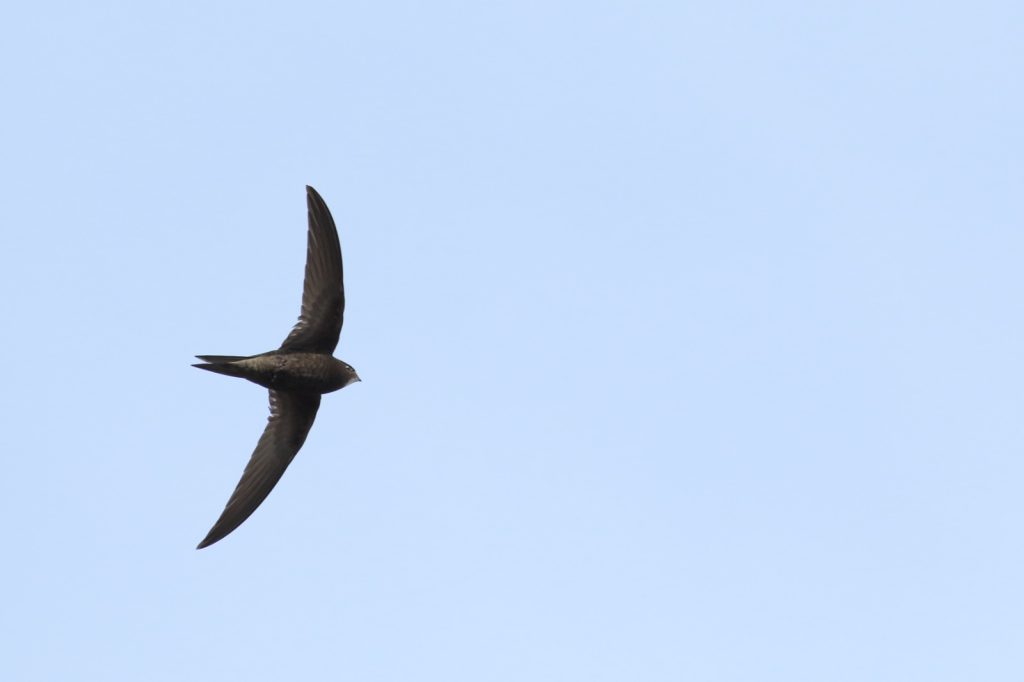
Swift in flight by Vaughn Matthews
How to Identify Swifts
In theory, telling Swifts apart from similar birds such as Swallows and House Martins should be simple, but as they often fly at fast speeds and high up, identification can be a challenge. Swifts are a uniform dark brown with a pale patch on their throats, but they generally appear as a dark silhouette against the sky. This in itself is a good identification feature as our Swallows and Martins have pale bellies. What I think is the real key ID feature for Swifts (other than their distinctive call) is the shape of their silhouette. Swifts have noticeably longer wings than Swallows and Martins and this gives them a crescent or anchor shape in flight.
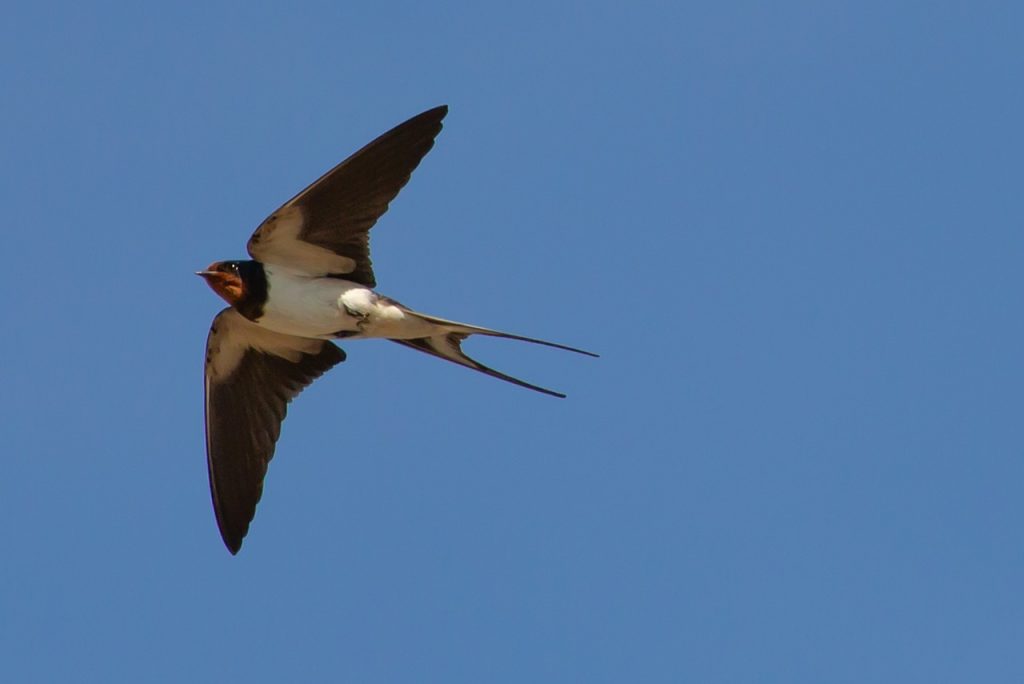
Underside of flying Swallow by TheOtherKev at Pixabay
One more thing to add is that if you see a bird perching on a wire or similar, then it will not be a Swift because Swifts only land to enter their nest. On a side note, Swallows can be distinguished from the others by their long tail streamers (in adults at least) with a pale belly but dark throat. House Martins are completely white on the underside of their bodies and also have a white rump patch (on their back) which is often noticeable at some distance.
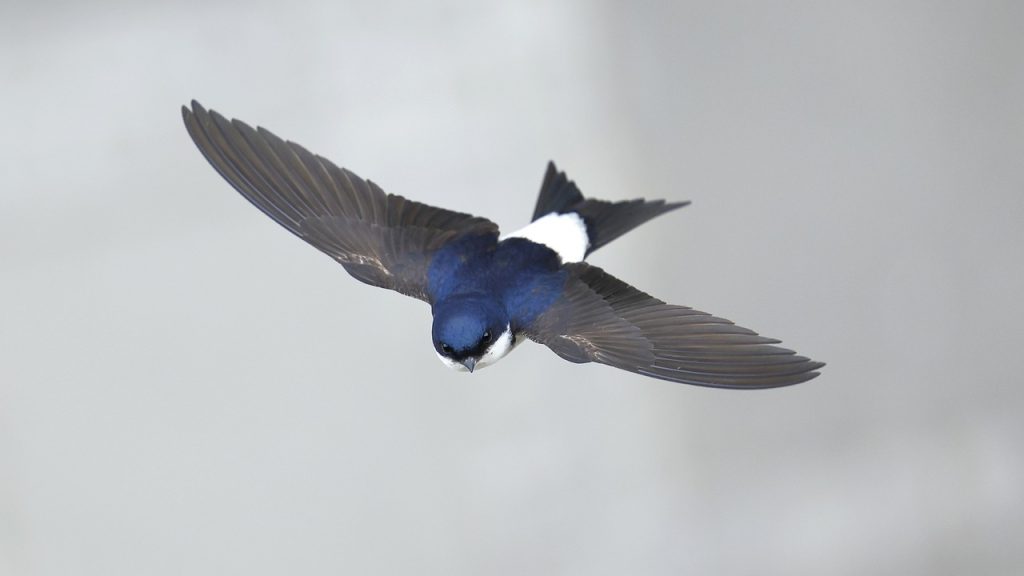
Flying House Martin showing white rump by Sharkolot at Pixabay
Swift Nests
Traditionally Swifts nested in crevices and holes in trees and cliffs but have adapted to nest in man-made structures. Now they mostly nest in buildings, finding gaps inside roofs. There are a few locations in the UK where they still nest in natural areas, including a colony on Lewes Castle overlooking Fall Bay, Rhossili.
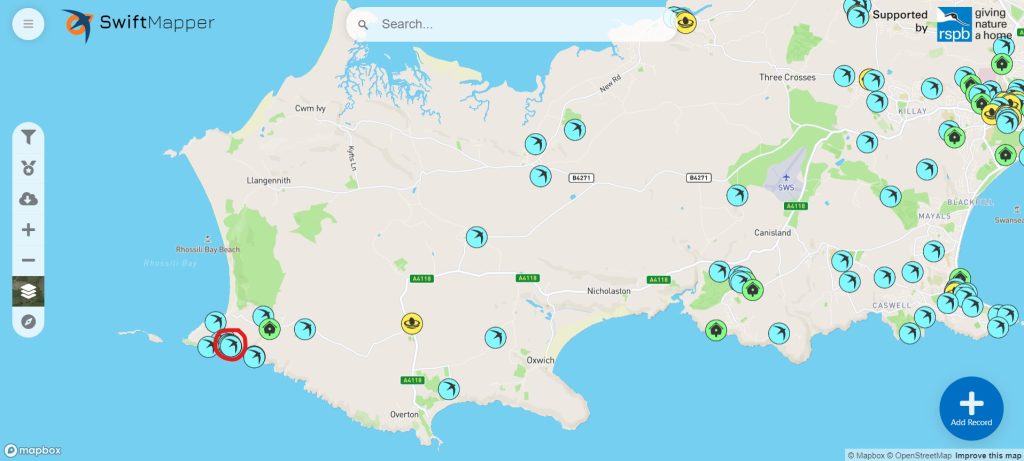
Swift Mapper showing Gower – Lewes Castle Swifts are circled in red
Unfortunately, as houses are renovated and plastic soffits are installed, Swifts are losing their nest sites. Swifts are very site loyal and will try to enter where their nest used to be, which can be quite distressing for the birds. The loss of Swift nesting sites has been recognised as a key factor in their recent decline, with numbers dropping by 60% in the UK since 1995. The decline in Wales has been even more severe at 74% in the same time period2. As a result, Swifts have been placed on the Birds of Conservation Concern Red List, meaning they are among the top priority for conservation. As insect eating birds, the decrease in insect populations is also a factor in their decline, as well as climate change.

Swift population trend for Wales – from the British Trust for Ornithology (BTO)2
Saving our Swifts
In response to the steep decline in Swifts in the UK, many Swift groups have been set up throughout the UK. Their primary purpose is to raise awareness of Swifts in their local areas, to protect current nest sites and provide new nest sites. A local Swift group was set up in early 2022 called Saving Swansea’s Swifts. This project is run jointly by Swansea Council and Gower Ornithological Society and covers the entire county of Swansea.
The first key aim of the project is to find the current Swift nesting sites so we can protect their existing populations. This is mainly done through surveying, but ad hoc records are also helpful. As the time that Swifts spend in the UK is short, so too is the survey season, beginning in early May when the Swifts arrive and finishing in mid-July when most young Swifts have fledged. We undertook group surveys in 2022 and 2023, and we will hold further surveys in 2024 and subsequent years. If you would like to get involved with any of our surveys, then please get in touch: swanseaswifts@gmail.com. Or follow us on Twitter and Instagram to find out when our next survey will be.
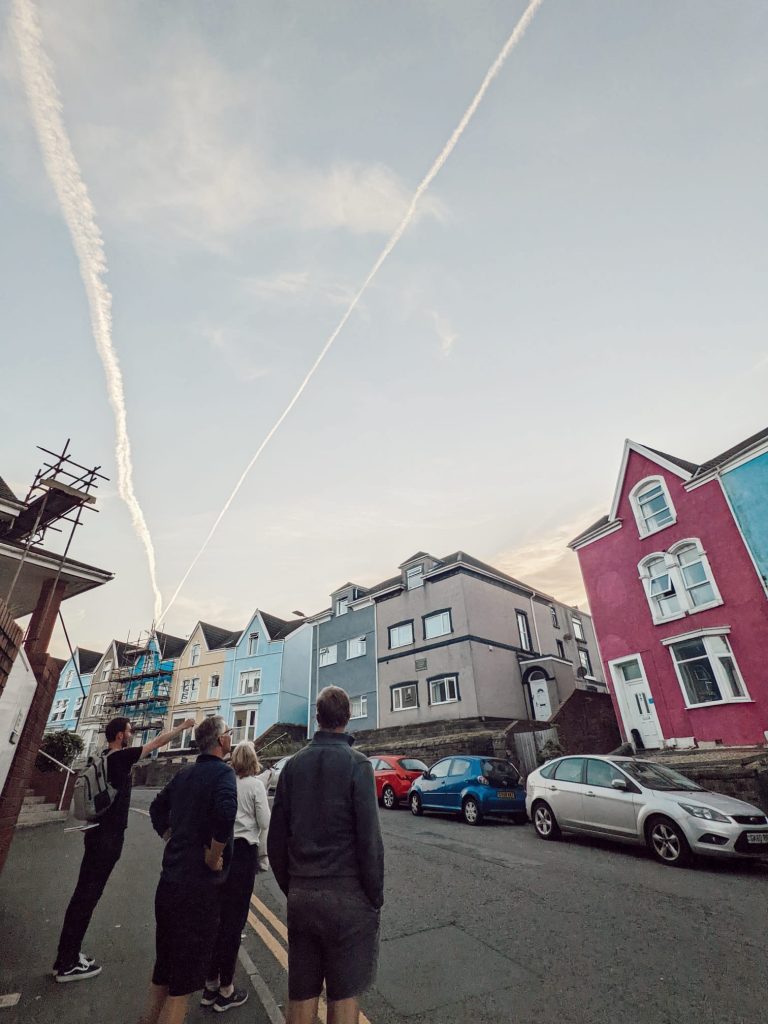
One of the Swift surveys in Brynmill in 2022
Please do also keep an eye out for Swifts when you are out and about. A group of Swifts flying low, around rooftop height is a good indication that they are nesting in a nearby building and you may even see them enter a nest. They will often be calling at the same time, hence the name ‘screaming parties’. If you do see this behaviour, or see any Swifts entering nests, then please add the sighting to Swift Mapper, as it helps us to know where Swifts are nesting. You can access Swift Mapper via the app or the website.
Swift Boxes
The other key aim of the project is to provide new nesting opportunities for Swifts. This is achieved through erecting Swift boxes or bricks. Through the project so far we have installed around 365 Swift boxes. These include 6 boxes that have recently been installed in the Pitton area by a local resident, including 3 on Pitton Chapel. Boxes can be supplied through the Saving Swansea’s Swifts Project, so please get in touch if you would like some.
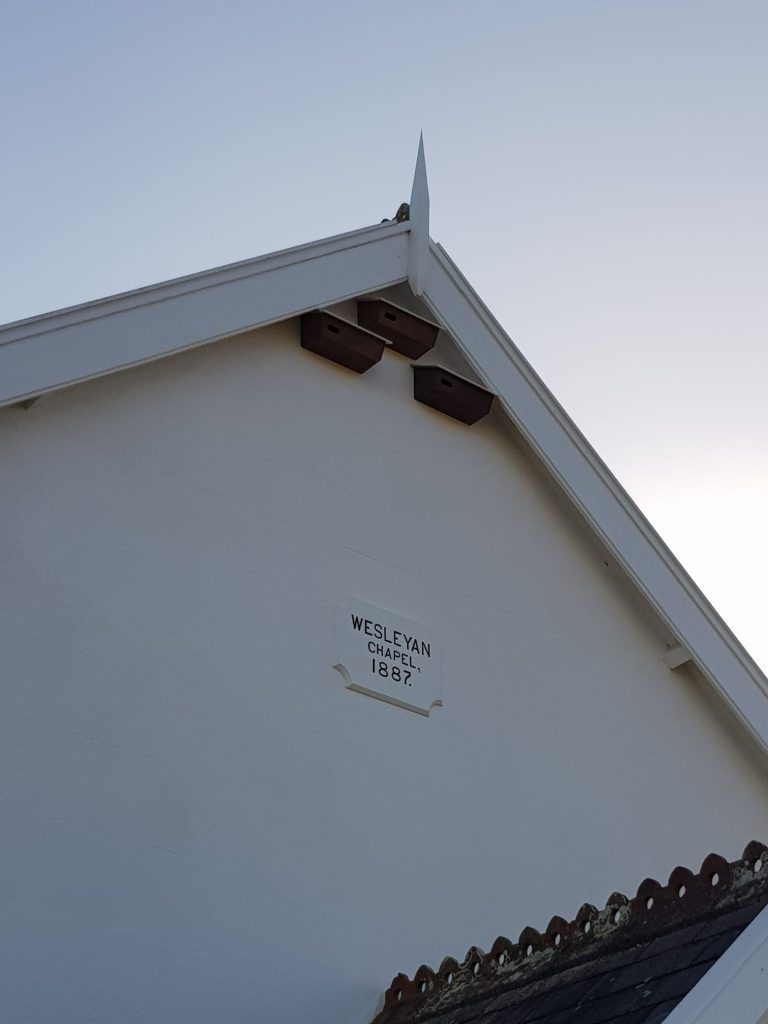
Swift boxes on Pitton Chapel
Boxes can be bought or if you’re feeling confident about your DIY skills you could make your own. I have attached a link to the RSPB’s guide on making your own Swift box. The diagram below shows the key information on where to site boxes to maximise the chance that Swifts will use them. Most importantly, the boxes should be at least 5m above the ground, on a north facing wall to prevent overheating in the summer sun, and have a good clearance around the box from any obstacles for a clear entry into the box and to minimise risk of predation (e.g. sparrowhawks and corvids in trees). Using a Swift caller system (playing Swift calls) can help to reduce the time it takes for Swifts to find the boxes and start nesting.
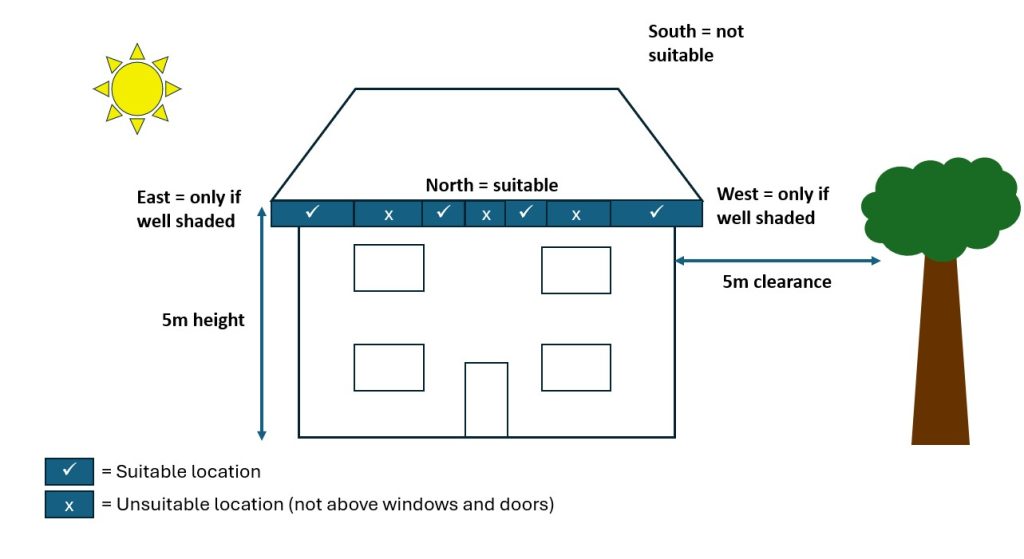
Diagram showing where to site Swift nest boxes
If you would like to buy your own Swift boxes, there are lots of options available in various designs. Some have the entrance hole on the front, and others on the base. Either of these work great for Swifts. Low-cost models include the John Stimpson boxes, which can be bought by emailing John Stimpson. Another good place for low-cost boxes is the RSPB shop.
If you have any further queries regarding Swifts, the Saving Swansea’s Swifts project, or boxes/bricks and caller systems then please do get in touch through our email or our social media. I have added some useful links below.
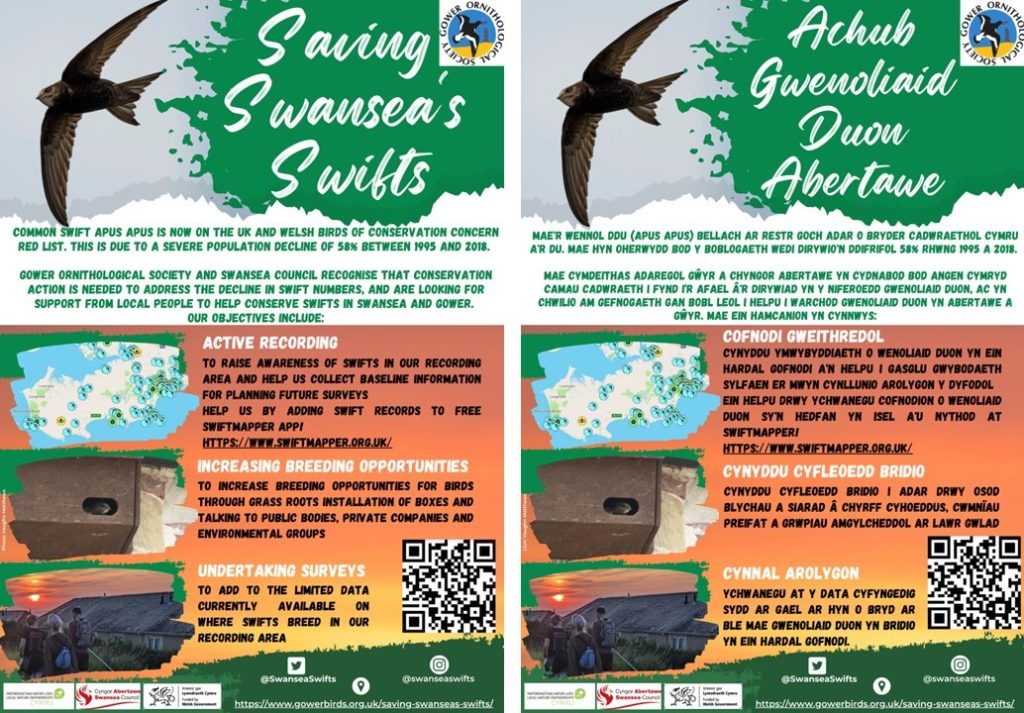
Saving Swansea’s Swifts Project Poster
Links:
Saving Swansea’s Swifts email: swanseaswifts@gmail.com
Swansea Swifts Twitter: @SwanseaSwifts
Swansea Swifts Instagram: @swanseaswifts
Swift Mapper: https://www.swiftmapper.org.uk/
Swift Conservation: https://www.swift-conservation.org/
Action for Swifts: https://actionforswifts.blogspot.com/
Gower Ornithological Society page: https://www.gowerbirds.org.uk/saving-swanseas-swifts/
Video clip of calling Swifts: https://www.youtube.com/watch?v=pEmtXsW2bD8
Buy an RSPB nestbox: https://shopping.rspb.org.uk/bird-feeders-boxes-tables/bird-houses-nest-boxes/garden-bird-nest-boxes/rspb-swift-nest-box.html
John Stimpson email for boxes: j.stimpson1@btopenworld.com
How to make a Swift box: https://www.rspb.org.uk/helping-nature/what-you-can-do/activities/create-a-high-home-for-swifts
BTO: https://www.bto.org/understanding-birds/birdfacts/swift
References:
1 http://news.bbc.co.uk/earth/hi/earth_news/newsid_8539000/8539383.stm
2 https://data.bto.org/trends_explorer/?species=Swift

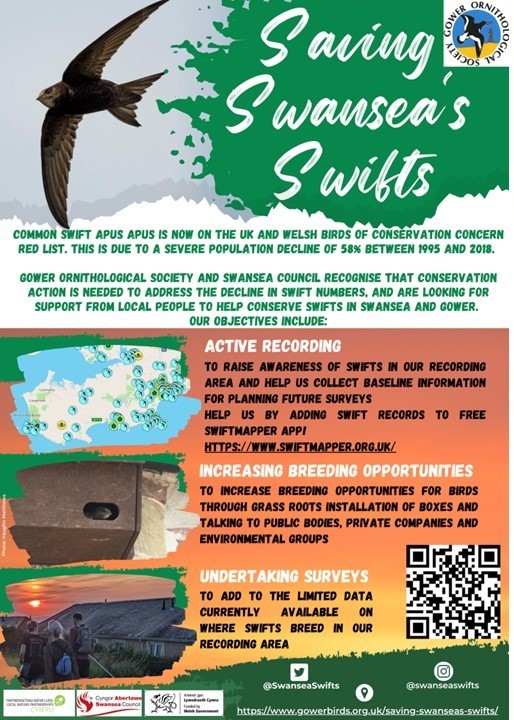
Excellent blog – thank you Josh. I’ve just started reading Mark Cocker’s One Midsummer’s Day – 300 pages on Swifts, so your blog was timely.
Looking at the Swift Mapper online I notice that the last occupied nest record for Lewes Castle was May 2021 which I suspect is not the last time swifts nested there but reflects how difficult it is to see them actually enter or leave a nest site and be sure that that is what you’ve seen. (Also interesting that there was a breeding record for Scurlage (in a barn) in May 2020.)
I think it’s quite a thing that the Swifts in Rhossili still nest in the cliffs, as their ancestors did prior to human settlements and it makes you wonder how long the Lewes Castle site may have been used. It seems this behaviour is quite rare now – it would be interesting to know quite how rare. It would be terrible to lose them.